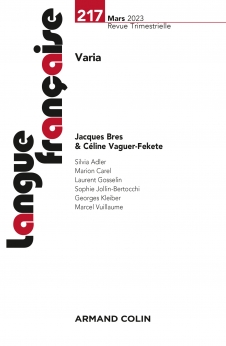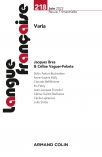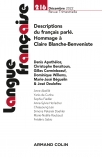
Langue française Nº217 (1/2023)
Pour acheter ce numéro, contactez-nous
Recevez les numéros de l'année en cours et accédez à l'intégralité des articles en ligne.
Cet article part des classifications proposées pour la cataphore, dont ressort le caractère formellement hétérogène, extensif et essentiellement discursif. La distinction entre vraies et fausses cataphores du point de vue référentiel prolonge cette observation et interroge la fonction du phénomène, qui apparaît fréquemment associé à des patrons lexico-syntaxiques et à l’ana-cataphore. Ce dernier aspect est confirmé par l’étude de la séquence ‹Quand il/elle + V, NP/SN› selon l’hypothèse de son statut phraséologique, qui permet d’observer un faisceau de fonctions textuelles liées à la relation cataphorique et au genre de texte.
This article starts from an inventory of the proposed typologies, which show their formally heterogeneous, extensive and essentially discursive character. The distinction between true and false cataphors from the referential point of view extends this observation and questions the function of the phenomenon, which appears by provision frequently associated with lexicalsyntactic patterns. Finally, a study of the sequence ‹Quand il/elle + V, NP/SN› according to the hypothesis of its phraseological status, allows us to observe a cluster of textual functions linked to the cataphoric relation and to the genre of the text.

